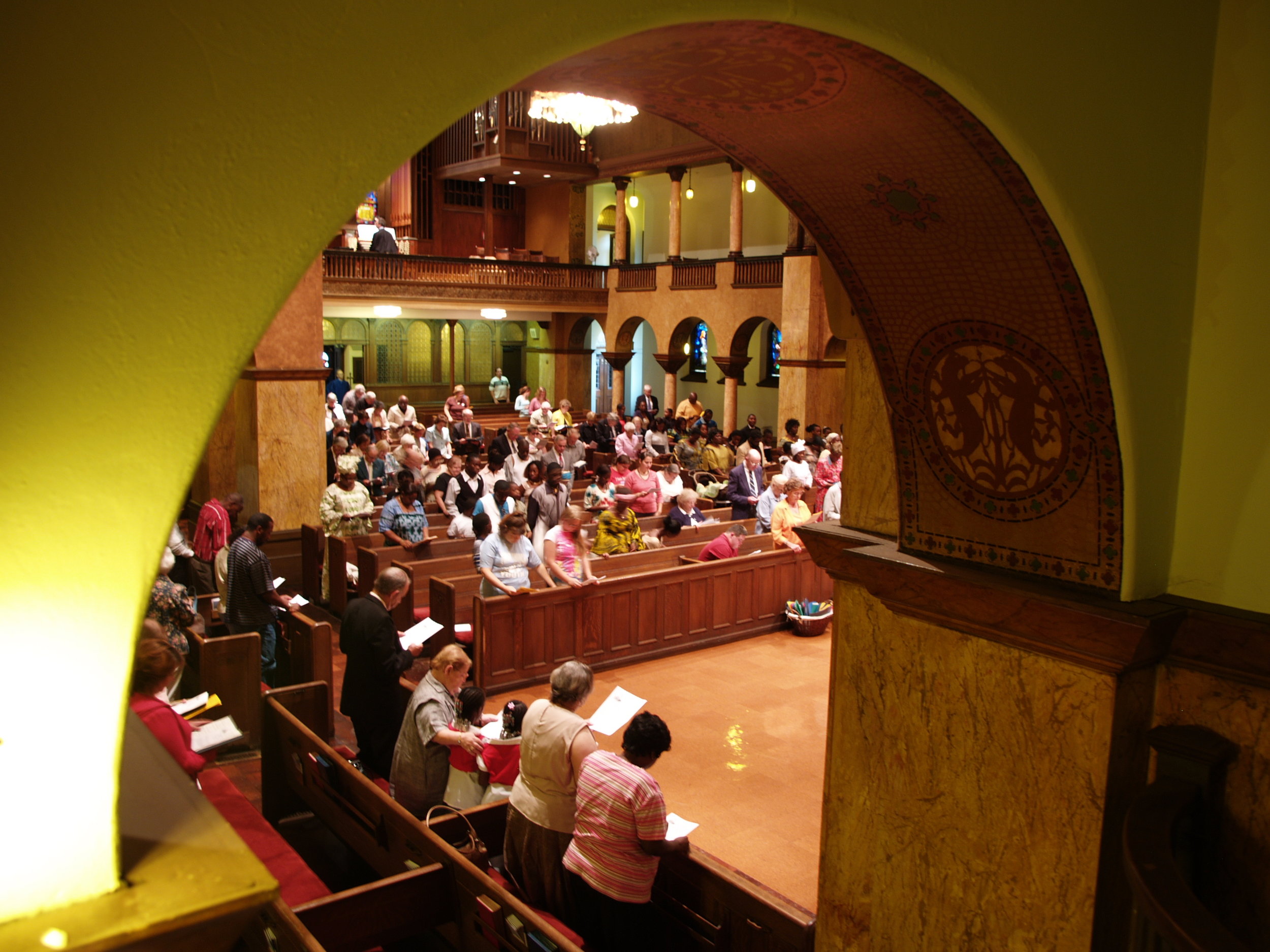
WORSHIP
As people of faith, worship is a central practice of our congregation. Every Sunday, and on multiple special occasions throughout the year, we come together to testify to and affirm God’s Word and mission through the creative practice of preaching, prayer, sacraments, and sacred music. These moments of worship enable us to better recognize God’s presence in our daily lives.
Our Worship Traditions
The following formalized description of Presbyterian worship carries the risk of communicating a rigid, even monotonous, rhythm and practice. Nothing could be further from the truth. Worship at First Church is a vivid and often profound experience that can engage and stimulate all five senses: sight, smell, hearing, taste, and touch. Most important of all are the internal, spiritual currents and transformations that worship may inspire in individuals, deepening their relationship with God and bringing about the conditions and opportunities to be in harmony with the world and all who live in it. Those who have experienced it will testify to the tiny, seemingly insignificant elements of worship—a phrase in a hymn, a petition in a prayer, an inflection in a singer’s voice—that trigger tears, memories, or joy, and sometimes all of these simultaneously, through the presence of God’s Spirit.
Worship may be understood in many ways, but at its root, it carries a sense of centering oneself in the presence of God. Before discussing any of the myriad forms in which collective worship is expressed, it is important to recognize that worship has a goal, which is to come into spiritual communion with the divine.
In the Presbyterian tradition, that desired outcome is helped along by a particular order of worship. Before describing a typical order, it needs to be stressed that Presbyterians enjoy a wide variety of ways of worshiping, and there is no single “right way.” The Presbyterian Church, however, has offered guidelines on how to conduct worship, with a sustained emphasis on two things: hearing and interpreting the Bible (the Word) and celebrating the sacraments of baptism and communion.
Sundays, of course, are the traditional focal point for Christian worship, and whenever the congregation gathers on the Lord’s Day, this is a commonly followed format for worship:
Gathering – The opening movement in which congregants greet one another, pray in silence, share announcements, or offer musical elements. Gathering also consists of spoken calls to worship (often based on the Psalms), hymns, prayer for the day, prayer of confession, and an assurance of pardon. Passing the peace of Christ to one another is another common feature of this movement, and one that cements the fellowship and conviviality of the congregation.
The Word – An essential element in which selections of Old and New Testament scripture are read, and those passages form the basis for the Word for the day to be “proclaimed,” that is, interpreted by the preacher in the sermon, meditation, or homily. The Word also may be proclaimed in other forms: interpretive dance, dramatic skit, visual art, or personal testimony. This phase of worship often includes a prayer for illumination and musical anthems from the choir or soloists.
Response – A segment in which the congregation acknowledges the message and theme of the day in several ways, including singing of hymns, unison reading of an affirmation of faith, prayers of intercession for particular concerns of those gathered, and a collection of tithes and offerings as an expression of gratitude for the gifts God has bestowed on the congregation, and as a contribution to the ongoing work of the church. Central to response are the two sacraments of the Protestant Reformation, communion and baptism. By their nature, these are not necessarily observed each Sunday, and the Presbyterian Church commonly celebrates communion once each month (often the first Sunday). Baptism, by contrast, is a sacrament celebrated only when an adult or a parent acting on behalf of a child asks the church to be baptized, is taught the meaning of the sacrament, and is approved by the Session of the church. Whether frequent or infrequent, the sacraments of communion and baptism are infused with theological significance as they emerge directly from the life and teachings of Jesus Christ, who Himself was baptized and inaugurated communion with his disciples at the Last Supper.
Sending – The final movement of worship, it often contains the highest level of congregational participation and initiative. It can be the setting for commissioning to ministries of evangelism, compassion, justice, and reconciliation. It may be marked by farewells to members of the church who are departing, or it may contain brief invitations or announcements related to the church’s mission. A closing hymn normally is offered and frequently expresses thanksgiving for the worship enjoyed by all and prayers for the safekeeping of the congregation when they are apart. A pastor’s charge to the congregation related to the sermon is often given, followed by a blessing of the congregation to recognize and enjoy the gifts of God which go with them out into the world.
It is important to note that while the service described above most often would be offered on Sunday (the Lord’s Day), in a church or chapel, Presbyterian worship can be celebrated at any time and in any place, including outdoors.
Moreover, there are a multitude of reasons and occasions that bring the worshiping community of First Church together. Seasonal highlights of the Christian liturgical year include Christmas, Lent, and Easter. But there are additional motivations for gathering and connecting to God and to each other:
Weddings
Funerals and memorial services
Ordination and Installation of clergy and lay leaders
Commissioning to service of a mission team or leader
Celebrating a congregational anniversary
Focusing on themes such as creation and ecology, and justice and reconciliation
Interfaith worship
Healing and wholeness
Daily prayer, vespers, and vigils
